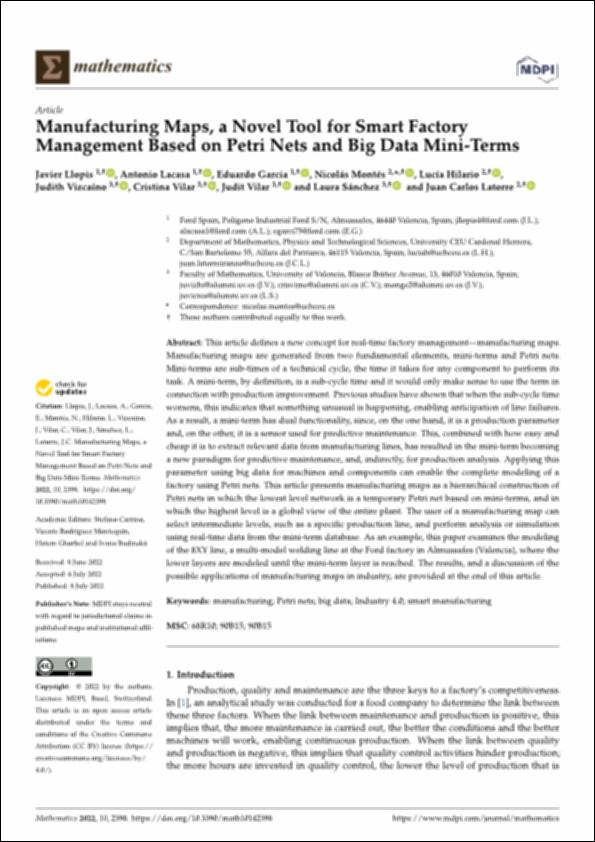Por favor, use este identificador para citar o enlazar este ítem:
http://hdl.handle.net/10637/14321Manufacturing maps, a novel tool for smart factory management based on Petri nets and big data mini-terms
| Título : | Manufacturing maps, a novel tool for smart factory management based on Petri nets and big data mini-terms |
| Autor : | Llopis Ballester, Javier Lacasa Corral, Antonio García Magraner, Eduardo Andrés Montés Sánchez, Nicolás Hilario Pérez, Lucía Vizcaíno Hilario, Judith Latorre Iranzo, Juan Carlos |
| Materias: | Petri nets.; Datos masivo - Aplicaciones en industria del automóvil.; Petri, Redes de.; Automobile industry and trade - Automation.; Automóviles - Fabricación - Teledetección.; Automóviles - Producción.; Industria del automóvil - Producción.; Big data in Automobile industry and trade.; Automobiles - Production.; Automobile industry and trade - Production.; Automobiles - Manufacturing - Remote sensing.; Industria del automóvil - Automatización. |
| Editorial : | MDPI |
| Citación : | Llopis, J., Lacasa, A., Garcia, E., Montés, N., Hilario, L., Vizcaíno, J., Vilar, C., et al. (2022). Manufacturing maps, a novel tool for smart factory management based on Petri nets and big data mini-terms. Mathematics, vol. 10, i. 14 (08 jul.), art. 398. DOI: http://dx.doi.org/10.3390/math10142398 |
| Resumen : | This article defines a new concept for real-time factory management—manufacturing maps. Manufacturing maps are generated from two fundamental elements, mini-terms and Petri nets. Mini-terms are sub-times of a technical cycle, the time it takes for any component to perform its task. A mini-term, by definition, is a sub-cycle time and it would only make sense to use the term in connection with production improvement. Previous studies have shown that when the sub-cycle time worsens, this indicates that something unusual is happening, enabling anticipation of line failures. As a result, a mini-term has dual functionality, since, on the one hand, it is a production parameter and, on the other, it is a sensor used for predictive maintenance. This, combined with how easy and cheap it is to extract relevant data from manufacturing lines, has resulted in the mini-term becoming a new paradigm for predictive maintenance, and, indirectly, for production analysis. Applying this parameter using big data for machines and components can enable the complete modeling of a factory using Petri nets. This article presents manufacturing maps as a hierarchical construction of Petri nets in which the lowest level network is a temporary Petri net based on mini-terms, and in which the highest level is a global view of the entire plant. The user of a manufacturing map can select intermediate levels, such as a specific production line, and perform analysis or simulation using real-time data from the mini-term database. As an example, this paper examines the modeling of the 8XY line, a multi-model welding line at the Ford factory in Almussafes (Valencia), where the lower layers are modeled until the mini-term layer is reached. The results, and a discussion of the possible applications of manufacturing maps in industry, are provided at the end of this article. |
| Descripción : | Este artículo se encuentra disponible en la siguiente URL: https://www.mdpi.com/2227-7390/10/14/2398 Este artículo de investigación pertenece al número especial "Industrial Big Data and Process Modelling for Smart Manufacturing". En este artículo de investigación también participan: Cristina Vilar, Judit Vilar y Laura Sánchez. |
| URI : | http://hdl.handle.net/10637/14321 |
| Derechos: | http://creativecommons.org/licenses/by/4.0/deed.es |
| ISSN : | 2227-7390 (Electrónico) |
| Idioma: | es |
| Fecha de publicación : | 8-jul-2022 |
| Centro : | Universidad Cardenal Herrera-CEU |
| Aparece en las colecciones: | Dpto. Matemáticas, Física y Ciencias Tecnológicas |
Los ítems de DSpace están protegidos por copyright, con todos los derechos reservados, a menos que se indique lo contrario.


